
The connection between these two angles is expressed by Snell’s law. The rays, points, and angles can be seen in the diagram below. Ray of incidence and the line of normal is called as the angle of incidence and the angle that is present between the ray of refraction and the line of normal is called the angle of refraction. The explanation is similar as in reflection, and it goes as the angle that is present between the The incident beam, the Normal, the refracted beam, and the incidence point are the components of refraction. As in reflection, similar components are present in refraction too. This particular phenomenon is termedĪs the refraction of light. The law of reflection says that, if a beam of light gets reflected off the surface, then the angle of incidence is the same as the angle of reflection.Īt the point when the light goes, starting with one medium then onto the next with various densities, then there is deviation in the path of light. Now the angle that is present between the ray of incidence and the line of normal is called the angle of incidence.Īlso, the angle that is present between the ray of reflection and the line of normal is called the angle of reflection.

This normal line isolates the angle present between the beams of incidence and reflection into two equal parts.

This drawn perpendicular at the surface is termed as normal line (marked N and the dotted line in the picture). The point at which the ray hits the mirror, at that point a line perpendicular to the interface can be made. The beam of light which is leaving that mirror is termed as the reflected beam (marked “R” and in the red shade in the picture). Incidence (marked “I” and in the Blue shade in the picture). In the figure, the beam of light moving toward the shown mirror is nothing but the ray of The outline underneath represents this particular law.

On the off chance that a beam of light is observed drawing closer and then reflecting off from the surface of a mirror (flat), at that point, the light’s behavior when it reflects will follow a certain law which is named as the law of reflection. Light is always expected to have predictable behavior. To have an idea of the angle of incidence, one needs to have an idea of the theory of reflection of light. Thus, in optics, we can define the angle of incidence to be the angle formed between the ray of incidence and a perpendicular line made on the surface (interface) at the exact point where the light is falling (incident).

Thus, an angle of incidence is said to be the angle between an incoming ray and the normal drawn on the surface of the material on which the ray is falling. The angle of incidence is the name given to the angle at which light falls or enters a surface. The angles made by the rays of lights while entering or falling on the surface have their unique names. This is just a normal event in transparent and translucent materials. This twisting of light isn't a unique phenomenon to prisms. The light generally changes its direction while entering a prism, and it changes its direction again while leaving the prism. On the off chance that you observed the white light sparkling into the prism, the primary thing you would have seen is its transformation into the rainbow, but the point to be noticed here is that the path taken by the light was not straight.


 0 kommentar(er)
0 kommentar(er)
